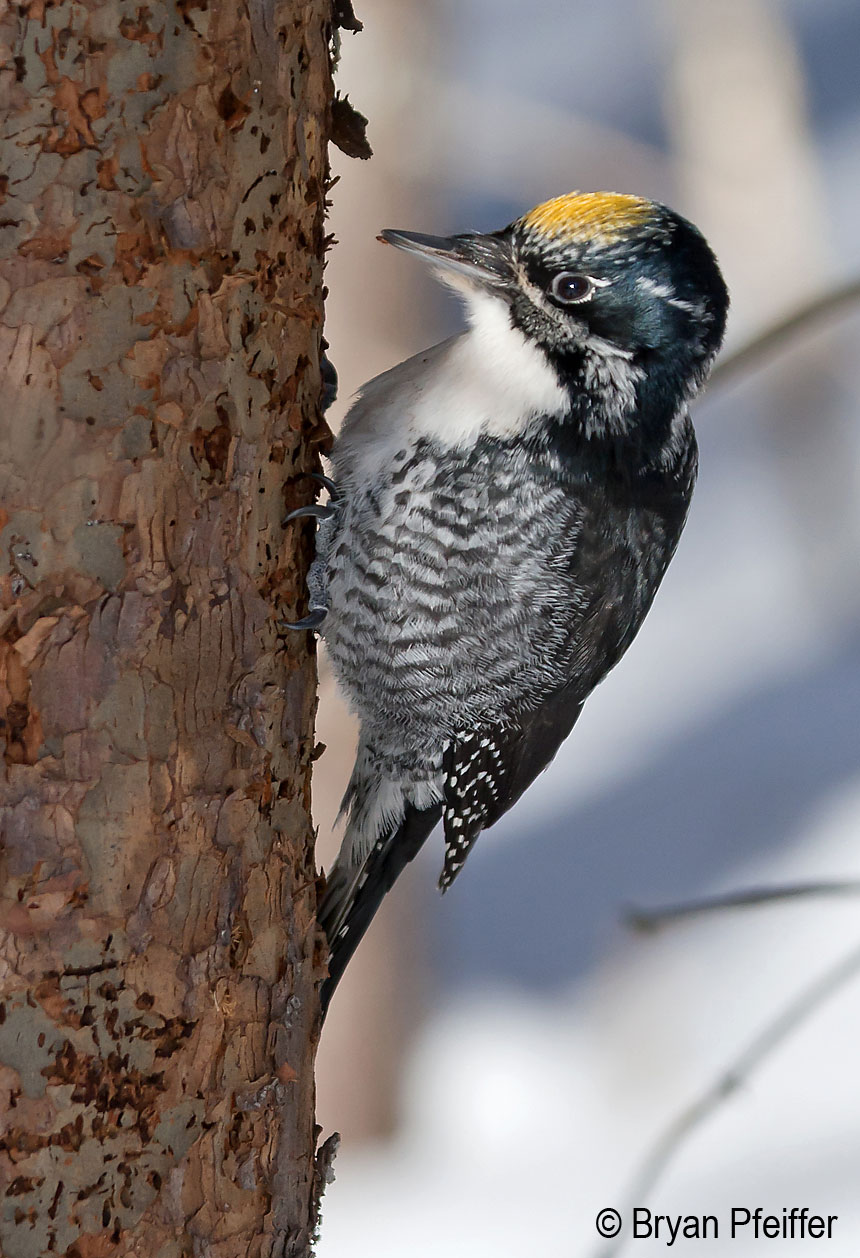Drum Roll, Please

Trees speak many languages: their leaves whoosh in summer, their trunks creak in winter. At the onset of spring trees become sounding boards for courtship. Before the thrushes and warblers arrive to sing from branches and boughs, woodpeckers kick off the spring chorus with a drum roll.
Although woodpeckers certainly vocalize, usually with sharp calls or harsh chattering, drumming is one of the most reliable early signs of spring – a proclamation of territoriality and an advertisement to the opposite sex.
Drumming is not to be confused with the arrhythmic tapping we hear from woodpeckers (and other cavity nesters like chickadees and nuthatches) as they excavate nest sites or forage for insects in bark. No, the drum roll, performed by males and females alike, is a force of nature – and fairly diagnostic to species. With a little practice, you can identify woodpeckers just by their drumming patterns.

American Three-toed Woodpecker / © Bryan Pfeiffer
An easy parlor trick, sure to impress your pals in the woods this spring, is to identify a distant Yellow-bellied Sapsucker. Early in migration, sapsuckers drum like no other woodpecker – not really a roll, but more like Morse code: a stuttered opening, and then steady tapping that slows in cadence and wanders away. Sapsuckers begin with bravado and end with reticence: Ta-tapity-tap … tap–tap–tap … tap … tap ….
There is no such reserve in the drum of a Pileated Woodpecker, our biggest head-banger, the one with the flaming crest. Pileateds drum with power, and that makes their drum roll relatively easy to distinguish. They often pound away high on a snag or big tree, producing a deep, resonant roll that lasts for three seconds or so. In a pileated’s drum, you often feel a hollow tree’s girth and age.
From here, the identification gets a bit more difficult. Your first real test in drumming class is to discern the drum rolls of the most widespread and abundant woodpeckers on the continent: Downy and Hairy. They look alike and they drum alike: a classic rapid roll.
But the bigger of the two species, the Hairy Woodpecker, drums faster and longer. A hairy’s drum lasts on average for a full second, and includes about 26 beats (plus or minus a few) in each rendition. The taps roll by so fast that you can just barely discern each one.
The Downy’s drum roll last about three-quarters of a second, but with half as many beats – about 13 on average. Yes, it’s still a drum roll, still fast. But in the downy’s performance (a staccato) you can pick out each tap and sense a pause in between.
One other way to tell the two apart is that the Downy seems more enterprising. It generally offers you nine to 16 drum rolls per minute during breeding season, pausing only a few second between each rendition. From the Hairy Woodpecker, you might only hear half as many drum rolls per minute — about four to nine of them.
I tend to lump our other common woodpeckers – the Red-bellied Woodpecker and Northern Flicker – into an “average drummers” category, not particularly fast or slow or distinctive. This makes them tougher to identify, but once you learn the easier drums, you’ll start to recognize that these two rolls are somewhat recognizable. Our two boreal woodpeckers – American Three-toed Woodpecker and Black-backed Woodpecker – tend to drum at an average pace, as well. But they sometimes prefer dead softwoods for their broadcasts, so their drums often sound a bit hollow.
These are all subtle distinctions. But woodpeckers, like the trees on which they tap, have distinctive voices. They shout their identities year-round. If only the trees, in their rustling and creaking, were as distinctive.

Hi Brian,
Sorry about my belated reply. They’re driving into metal as part of their territorial routine (rather than feeding). My assumption is that they might prefer it because it’s louder. (Even though it might indeed be fun.) 🙂
Sometimes one (or more) of our local pileated woodpeckers drills into metal on our property – either the corrugated roof a small barn or the metal dome of an old grain bin. The latter reverberates like crazy, echoing from within. The birds must know they’re driving metal, not wood. Do you think they do it for fun?
Get a photo of the flicker. ..yes. She is a natural!
Thanks, Rokllin! Get it, like as in understand it? Or get photos of it?
Neither of us is as good as Adelie, of course! 🙂
Outstanding photos! I cannot get the flicker!
Rollin